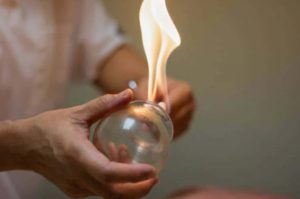Cupping, 30 Mins, $60
The original cups were made from carved-out animal horns. This ancient Chinese practice of cupping is in The Handbook of Prescriptions, an early fourth-century text written by the herbalist Ge Hong. It appears to have become particularly popular during the Qing and Tang dynasties, with herbalist manuals from this era describing the practice in great detail. The beneficial effects include alleviating headaches, abdominal pain and dizziness.
The carved out animal horns with sanded edges to form a seal on the surface of the skin would be heated and placed upside down on the skin. The heat would create a vacuum over the desired meridian or acupoint (the points where different circuits of qi – vital life energy – intersect).
At Beauty-Full Spa in Pickering, we use different sizes of custom-made glass jars just for this purpose. We employ the dry cupping method as we have found it to be the most efficient method and is needle-free. Unlike other types of jars or cones used, the glass allows us to see what is going on with the vacuum and the effectiveness of the treatment.
The focus and desired outcome of cupping is the release of pain and increased blood flow in the treated area. Cupping works in much the same way as acupuncture by stimulating the blood flow in and around the meridians or acupoints to remove blockages that are preventing qi (vital life energy) from flowing smoothly around the body. This is a welcomed addition to a lower back massage for anyone suffering from discomfort in their lower back area.
This is accomplished by inserting a wad of alcohol-soaked cotton wool inside the cup once the wad has been lit on fire. It is a very fast process with only a few seconds required to generate sufficient heat inside the cup with the heat source removed. Next, the cup is quickly inverted and strategically placed on the client’s skin over the area to be treated. The burning of the cotton wool removes all oxygen which creates a vacuum inside the cup so that when it is inverted and placed on the body, it draws up the skin and flesh beneath as it cools.
 The cup is left in place for 5-10 minutes or longer if required, during which time it exerts a gentle pressure on the meridian, opens the pores, stimulates the blood’s circulation, breaks down obstructions, allows toxins to flow out of the acupoint and in this way realigns and balances the healthy flow of qi.
The cup is left in place for 5-10 minutes or longer if required, during which time it exerts a gentle pressure on the meridian, opens the pores, stimulates the blood’s circulation, breaks down obstructions, allows toxins to flow out of the acupoint and in this way realigns and balances the healthy flow of qi.
Cupping is generally used on the fleshier areas of the body, such as the stomach, back, and occasionally legs and arms. The exact number of cups used and the amount of time they are left in place depends on the condition being treated.
Cupping is primarily used in China as a treatment for congestion, asthma, bronchitis and other respiratory disorders, some types of pain, and gastroenteritis and other abdominal conditions. It can also help to reduce swelling and alleviate depression.
There are many pictures on Google Images showing “after cupping pictures,” do not be alarmed. The pink area (as it appears on a white person) left after cupping can look very traumatic and painful. The only side effects may be some slight circular bruising and/or swelling afterwards, which is caused by the drawing up of tiny blood vessels into the vacuum, but this quickly goes down for most people within a day or so of treatment and is not usually painful. For clients with very sensitive skin, the bruising may last a week or two, be assured it does disappear. The general joke is to tell people that you were struck by an octopus.
Cupping is not suitable for every person. People who suffer from convulsions, inflamed skin or who have a high fever, are suffering from inflammation, taking a blood thinner or bleed easily should not undergo cupping. Pregnant women should avoid cupping on the lower back and stomach. In addition, an experienced practitioner will not usually move cups over bony parts of the body, such as the shoulder blades or spinal bumps.


